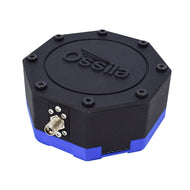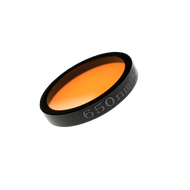Optical Spectrometer

An optical spectrometer, also known as an optical spectrophotometer or spectrograph, is an instrument which measures light intensity across different wavelengths of the electromagnetic spectrum. This typically focuses on wavelengths within the visible light range (between 320-1000 nm).

By analyzing how light interacts with a material or sample, optical spectrometers (such as the Ossila USB Spectrometer) can provide valuable information about a material’s structure, composition, and properties. The specific wavelengths of light that a material absorbs, transmits or emits will provide valuable insights into its potential applications.
To measure intensity at different wavelengths, the spectrometer must first isolate the light signal, separate it into its wavelength components, and finally measure the intensities. Therefore, most systems consist of four main components:
- Entrance slit: The entrance slit controls how much light is allowed into the optical spectrometer.
- Diffraction grating: Diffraction gratings split the incoming light into its constituent wavelengths. Longer wavelengths of light will be diffracted at a larger angle than light with shorter wavelengths.
- Detector: This diffracted light is routed towards a detector such as a CCD array or other photodiode device. This detector will measure the intensity of the separated light. This data is then processed to create a spectrum.
- Optics and mirrors: Various internal optics and mirrors direct light within the spectrometer, ensuring minimal signal is lost.
USB Spectrometer

Taking Measurement with an Optical Spectrometer
The optical spectrometer itself takes an incoming light signal and generates a spectrum showing intensity against wavelength. For most spectroscopy measurements, users must direct light from a source onto a sample, then measure the light transmitted or emitted from it. Therefore, you need several other components to take accurate spectroscopy measurements including: a light source, a sample holder, positioning equipment. Positioning equipment, such as a breadboard, or optical fibers will help to direct your signal correctly, minimizing signal losses and reducing background noise.
Optical Spectrometer Applications
Optical spectrometers are used in many types of spectroscopy including absorbance, photoluminescence, fluorescence, transmission, reflection, optical density measurements and more. These fundamental spectroscopy techniques are extremely useful in many areas of research and production.
Characterizing Light Sources
Optical spectrometers are essential for characterizing light sources, such as LEDs, lasers and other light emitting devices. You can measure the strength, wavelength and purity of emitted light from a fluorescent or light emitting device.
Measuring Absorbance, Reflection or Fluorescence
Many different materials are defined by how they interact with light. In absorbance spectroscopy, an optical spectrometer measures how much light is absorbed by a sample at different wavelengths. Fluorescent materials, on the other hand, absorb light at one wavelength and emit it at another.
These properties are useful in many different situations. For example, specific coatings are used to reduce the amount of light reflected off a surface, creating anti-glare coatings on windows. Alternatively, fluorophores (or fluorescent materials) can be used as biological tags or to monitor chemical reactions. Using an optical spectrometer, researchers can characterize the optical properties of many different materials.

Characterizing Optoelectronic Devices
Optical spectrometers play a crucial role in developing and testing optoelectronic devices, such as solar cells and photodiodes. By analyzing absorbance and photoluminescence of different layers, both inside and outside of a device, you can better understand how light interacts with these optoelectronic materials.
Concentration Measurements in Solution
In chemistry and biochemistry, optical spectrometers are frequently used to determine the concentration of a substance or species in solution. This is often known as optical density. By applying the Beer-Lambert law, which correlates absorbance with concentration, you can measure the concentration of a particular material. This is also a quick and reliable measurement which is useful in fields such as environmental monitoring and medical diagnostics.
Quality Control And Assurance
Optical spectrometers play a vital role in quality control in various industries, including pharmaceuticals, food production, and manufacturing. Optical spectroscopy measurements can help verify the purity, consistency, and composition of products, without directly interacting with the product itself.
The USB Optical Spectrometer
Our USB spectrometer and optical spectroscopy kit makes conducting UV-Vis spectroscopy experiments simple and affordable.




